oil pressure MERCEDES-BENZ S-Class 2013 W221 Owner's Manual
[x] Cancel search | Manufacturer: MERCEDES-BENZ, Model Year: 2013, Model line: S-Class, Model: MERCEDES-BENZ S-Class 2013 W221Pages: 542, PDF Size: 7.97 MB
Page 6 of 542
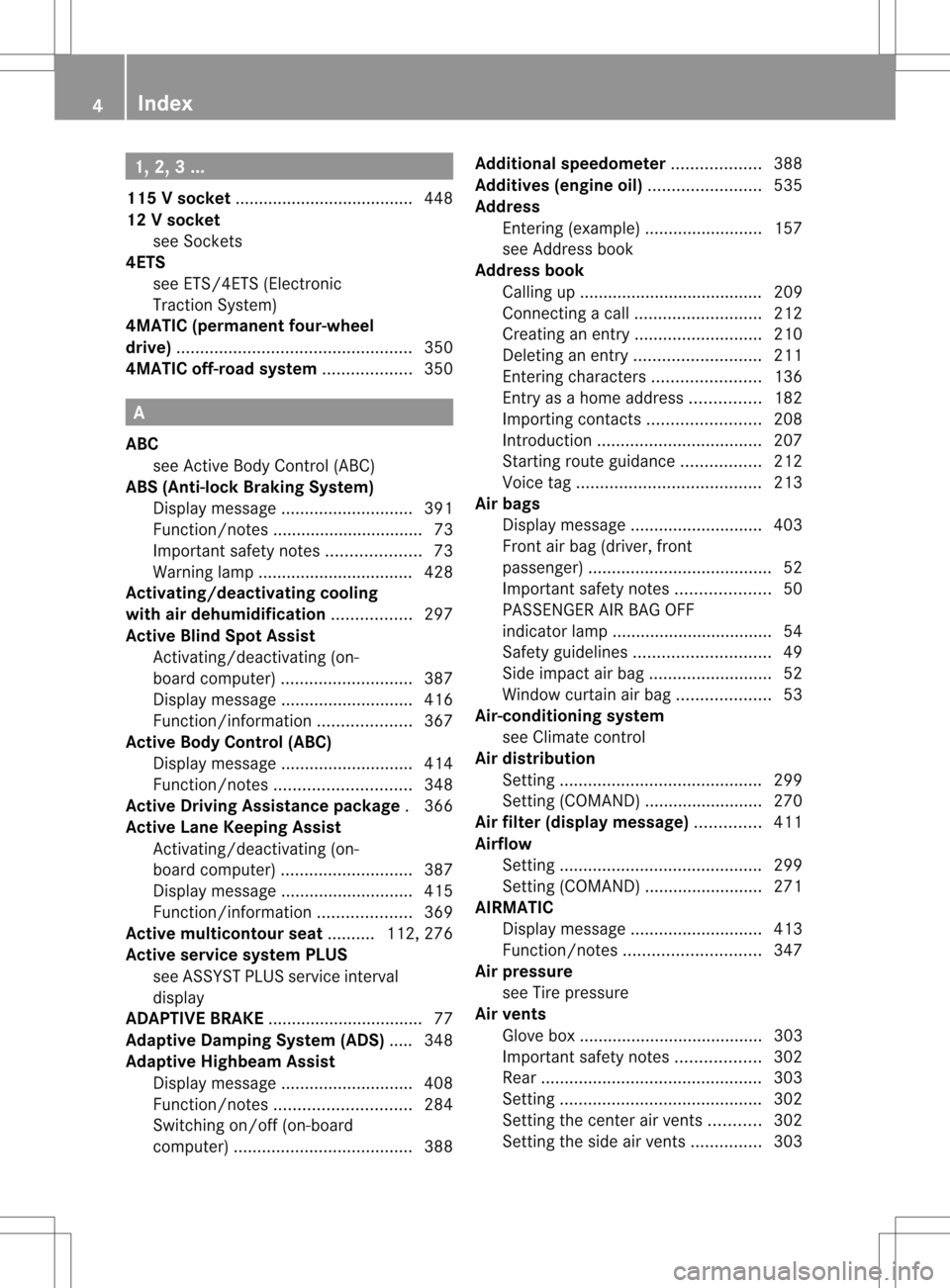
1, 2, 3 ...
115 Vsocket ...................................... 448
12 Vsocket
see Sockets
4ETS
see ETS/4ETS (Electronic
Tractio nSystem)
4MATIC (permanent four-wheel
drive) .................................................. 350
4MATIC off-road system ...................350 A
ABC see Active Body Control (ABC)
ABS (Anti-lock Braking System)
Display message ............................ 391
Function/notes ................................ 73
Important safety notes ....................73
Warning lamp ................................. 428
Activating/deactivating cooling
with air dehumidification .................297
Active Blin dSpot Assist
Activating/deactivating (on-
board computer) ............................ 387
Display message ............................ 416
Function/informatio n.................... 367
Active Body Control (ABC)
Display message ............................ 414
Function/notes ............................. 348
Active Driving Assistance package .366
Active Lane Keeping Assist Activating/deactivating (on-
board computer) ............................ 387
Display message ............................ 415
Function/informatio n.................... 369
Active multicontour seat ..........112, 276
Active service syste mPLUS
see ASSYS TPLUS service interval
display
ADAPTIVE BRAKE .................................77
Adaptive Damping System (ADS) .....3 48
Adaptive Highbeam Assist Display message ............................ 408
Function/notes ............................. 284
Switching on/off (on-board
computer) ...................................... 388Additional speedometer
...................388
Additives (engine oil) ........................535
Address Entering (example )......................... 157
see Addres sbook
Address book
Calling up ....................................... 209
Connecting acall........................... 212
Creating an entry ........................... 210
Deleting an entry ........................... 211
Entering characters .......................136
Entry as ahome address ...............182
Importing contacts ........................208
Introduction ................................... 207
Starting route guidance .................212
Voice tag ....................................... 213
Airb ags
Display message ............................ 403
Front air bag (driver, front
passenger )....................................... 52
Important safety notes ....................50
PASSENGER AIR BAG OFF
indicator lamp .................................. 54
Safety guidelines ............................. 49
Side impact airb ag.......................... 52
Windo wcurtain air bag .................... 53
Air-conditioning system
see Climate control
Aird istribution
Settin g........................................... 299
Setting (COMAND) .........................270
Airf ilter (display message) ..............411
Airflow Setting ........................................... 299
Setting (COMAND) .........................271
AIRMATIC
Display message ............................ 413
Function/notes ............................. 347
Air pressure
see Tire pressure
Airv ents
Glove box ....................................... 303
Important safet ynotes .................. 302
Rea r............................................... 303
Setting ........................................... 302
Setting the center air vents ...........302
Setting the side air vents ...............303 4
Index
Page 26 of 542
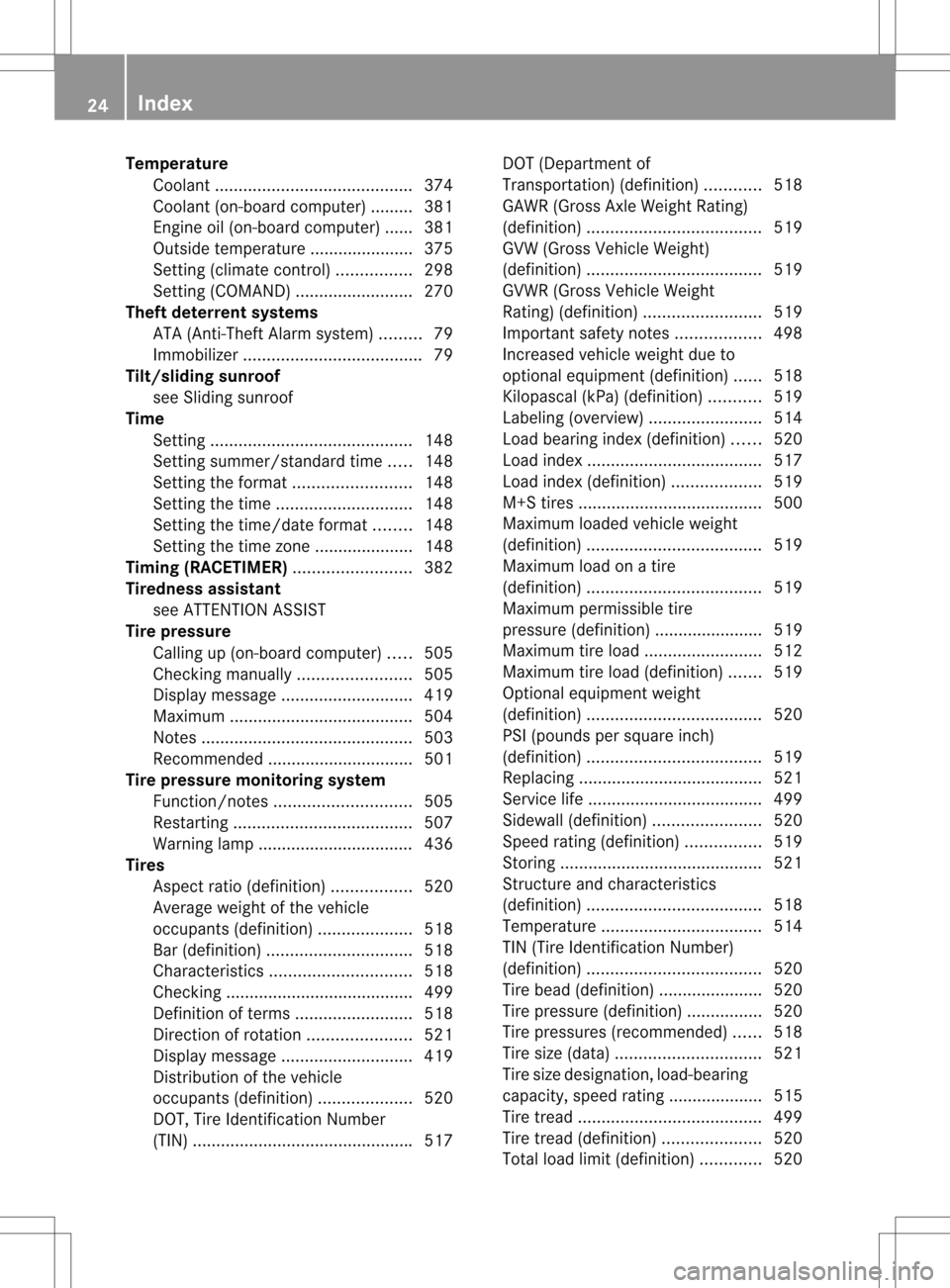
Temperature
Coolant .......................................... 374
Coolant (on-board computer) ......... 381
Engine oil (on-board computer) ...... 381
Outside temperature ..................... .375
Setting (climate control) ................298
Setting (COMAND) .........................270
Theft deterrent systems
ATA (Anti-Theft Alarm system) .........79
Immobilize r...................................... 79
Tilt/sliding sunroof
see Sliding sunroof
Time
Setting ........................................... 148
Setting summer/standard time .....148
Setting the forma t......................... 148
Setting the time ............................. 148
Setting the time/date forma t........ 148
Setting the time zone ..................... 148
Timing (RACETIMER) .........................382
Tiredness assistant see ATTENTION ASSIST
Tire pressure
Calling up (on-board computer) .....505
Checking manually ........................505
Display message ............................ 419
Maximum ....................................... 504
Notes ............................................. 503
Recommended ............................... 501
Tire pressure monitoring system
Function/notes ............................. 505
Restarting ...................................... 507
Warning lamp ................................. 436
Tires
Aspect ratio (definition) .................520
Average weight of the vehicle
occupants (definition) ....................518
Bar (definition) ............................... 518
Characteristics .............................. 518
Checking ........................................ 499
Definition of terms .........................518
Direction of rotatio n...................... 521
Display message ............................ 419
Distributio nofthe vehicle
occupants (definition) ....................520
DOT, Tire Identification Number
(TIN) .............................................. .517 DOT (Department of
Transportation) (definition)
............518
GAWR (Gross Axle Weight Rating)
(definition) ..................................... 519
GVW (Gross Vehicle Weight)
(definition) ..................................... 519
GVWR (Gross Vehicle Weight
Rating) (definition) .........................519
Important safety notes ..................498
Increased vehicle weight due to
optional equipment (definition) ......518
Kilopascal (kPa) (definition) ...........519
Labeling (overview )........................ 514
Load bearing index (definition) ......520
Load index ..................................... 517
Load index (definition) ...................519
M+S tires ....................................... 500
Maximum loaded vehicle weight
(definition) ..................................... 519
Maximum load on a tire
(definition) ..................................... 519
Maximum permissible tire
pressure (definition) ....................... 519
Maximum tire loa d......................... 512
Maximum tire load (definition) .......519
Optional equipment weight
(definition) ..................................... 520
PSI (pounds per square inch)
(definition) ..................................... 519
Replacing ....................................... 521
Service life ..................................... 499
Sidewall (definition) .......................520
Speed rating (definition) ................519
Storing ........................................... 521
Structure and characteristics
(definition) ..................................... 518
Temperature .................................. 514
TIN (Tire Identification Number)
(definition) ..................................... 520
Tire bea d(definition) ...................... 520
Tire pressure (definition) ................520
Tire pressures (recommended )...... 518
Tire size (data) ............................... 521
Tire size designation, load-bearing
capacity, speed rating .................... 515
Tire tread ....................................... 499
Tire tread (definition) .....................520
Total load limit (definition) .............520 24
Index
Page 323 of 542
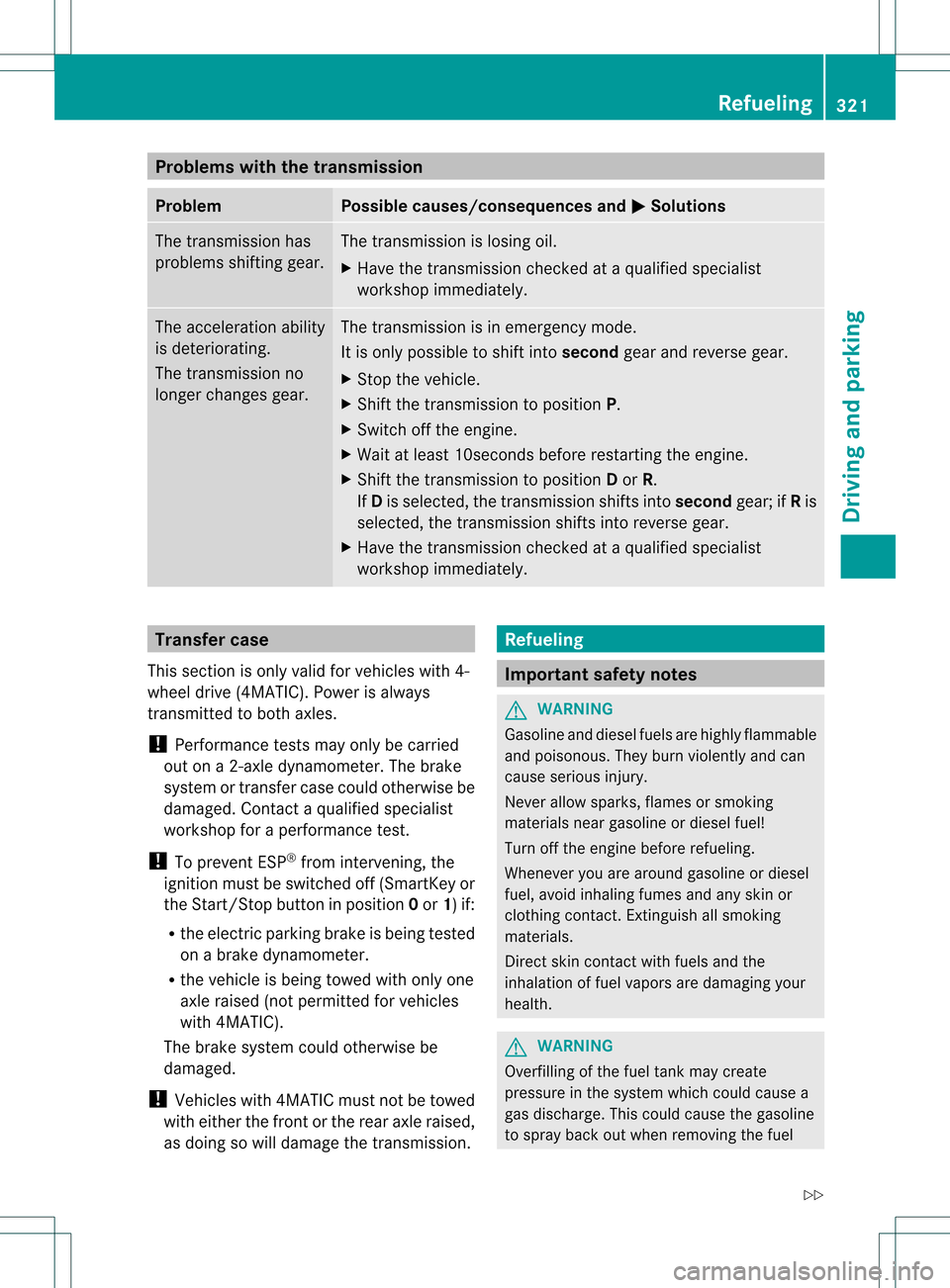
Problems with the transmission
Problem Possible causes/consequences and
0004 Solutions
The transmission has
problems shifting gear. The transmission is losing oil.
X
Have the transmission checked at a qualified specialist
workshop immediately. The acceleration ability
is deteriorating.
The transmission no
longer changes gear. The transmission is in emergency mode.
It is only possible to shift into
secondgear and reverse gear.
X Stop the vehicle.
X Shift the transmission to position P.
X Switch off the engine.
X Wait at least 10seconds before restarting the engine.
X Shift the transmission to position Dor R.
If D is selected, the transmission shifts into secondgear; ifRis
selected, the transmission shifts into reverse gear.
X Have the transmission checked at a qualified specialist
workshop immediately. Transfer case
This section is only valid for vehicles with 4-
wheel drive (4MATIC). Power is always
transmitted to both axles.
! Performance tests may only be carried
out on a 2-axle dynamometer. The brake
system or transfer case could otherwise be
damaged. Contact a qualified specialist
workshop for a performance test.
! To prevent ESP ®
from intervening, the
ignition must be switched off (SmartKey or
the Start/Stop button in position 0or 1) if:
R the electric parking brake is being tested
on a brake dynamometer.
R the vehicle is being towed with only one
axle raised (not permitted for vehicles
with 4MATIC).
The brake system could otherwise be
damaged.
! Vehicles with 4MATIC must not be towed
with either the front or the rear axle raised,
as doing so will damage the transmission. Refueling
Important safety notes
G
WARNING
Gasoline and diesel fuels are highly flammable
and poisonous. They burn violently and can
cause serious injury.
Never allow sparks, flames or smoking
materials near gasoline or diesel fuel!
Turn off the engine before refueling.
Whenever you are around gasoline or diesel
fuel, avoid inhaling fumes and any skin or
clothing contact. Extinguish all smoking
materials.
Direct skin contact with fuels and the
inhalation of fuel vapors are damaging your
health. G
WARNING
Overfilling of the fuel tank may create
pressure in the system which could cause a
gas discharge. This could cause the gasoline
to spray back out when removing the fuel Refueling
321Driving and parking
Z
Page 379 of 542

Menus and submenus
Menu overview
The number of menus show ndepends on the optional equipment in the vehicle. Function
0002
Trip menu (Y
page 378) 0003
Navi menu (navigation instructions) (Y
page 379)0026
Audio menu (Y
page 380) 0025
AMG menu in AMG vehicles (Y
page 381)0023
Telephone menu (Y
page 384) 0024
DriveAssist menu (Y
page 385) 0014
Service menu (Y
page 387)
R calling up display messages ( Ypage 390)
R checking the tire pressure electronically (Y page 505)
R calling up a service due date (Y page 469)
R oil level chec k(Ypage 463) 0015
Settings menu (Y
page 387) Menus and submenus
377On-board computer and displays Z
Page 389 of 542
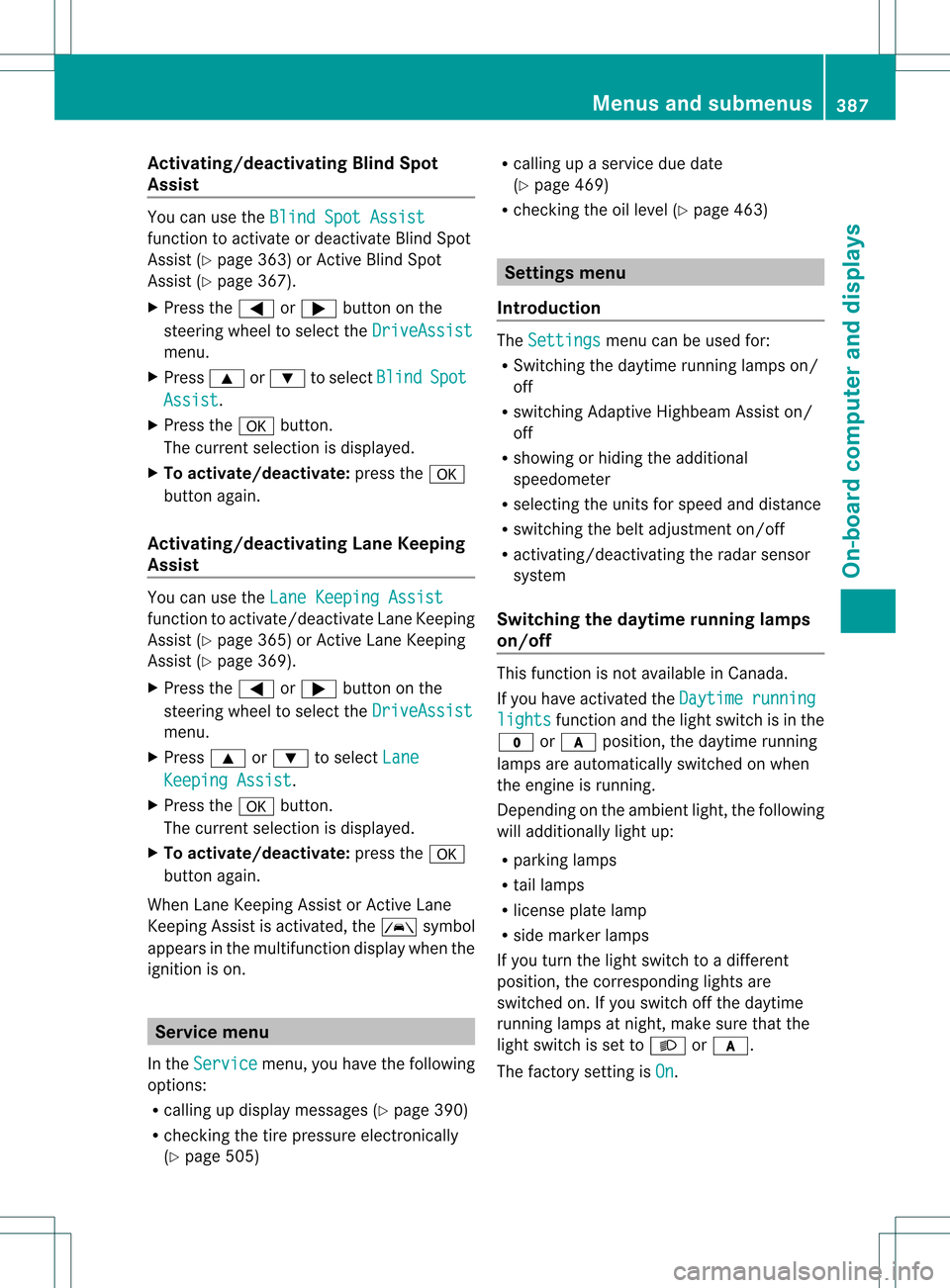
Activating/deactivating Blind Spot
Assist You can use the
Blind Spot Assist function to activate or deactivate Blind Spot
Assis t(Ypage 363) or Active Blind Spot
Assist (Y page 367).
X Press the 0009or000C button on the
steering wheel to select the DriveAssistmenu.
X Press 000Aor000B to select Blind Spot
Assist .
X Press the 0011button.
The curren tselection is displayed.
X To activate/deactivate: press the0011
button again.
Activating/deactivating Lane Keeping
Assist You can use the
Lane Keeping Assist function to activate/deactivate Lane Keeping
Assist (Y
page 365) or Active Lane Keeping
Assist (Y page 369).
X Press the 0009or000C button on the
steering wheel to select the DriveAssistmenu.
X Press 000Aor000B to select Lane Keeping Assist .
X Press the 0011button.
The curren tselection is displayed.
X To activate/deactivate: press the0011
button again.
When Lane Keeping Assist or Active Lane
Keeping Assist is activated, the 0001symbol
appears in the multifunction display when the
ignition is on. Service menu
In the Service menu, you have the following
options:
R calling up display messages ( Ypage 390)
R checking the tire pressure electronically
(Y page 505) R
calling up a service due date
(Y page 469)
R checking the oil level (Y page 463) Settings menu
Introduction The
Settings menu can be used for:
R Switching the daytime running lamps on/
off
R switching Adaptive Highbeam Assist on/
off
R showing or hiding the additional
speedometer
R selecting the units for speed and distance
R switching the belt adjustment on/off
R activating/deactivating the radar sensor
system
Switching the daytime running lamps
on/off This function is not available in Canada.
If you have activated the
Daytime running
lights function and the light switch is in the
000E or000D position, the daytime running
lamps are automatically switched on when
the engine is running.
Depending on the ambient light, the following
will additionally light up:
R parking lamps
R tail lamps
R license plate lamp
R side marker lamps
If you turn the light switch to a different
position, the corresponding lights are
switched on. If you switch off the daytime
running lamps at night, make sure that the
light switch is set to 000Aor000D.
The factory setting is On .Menus and submenus
387On-board computer and displays Z
Page 413 of 542
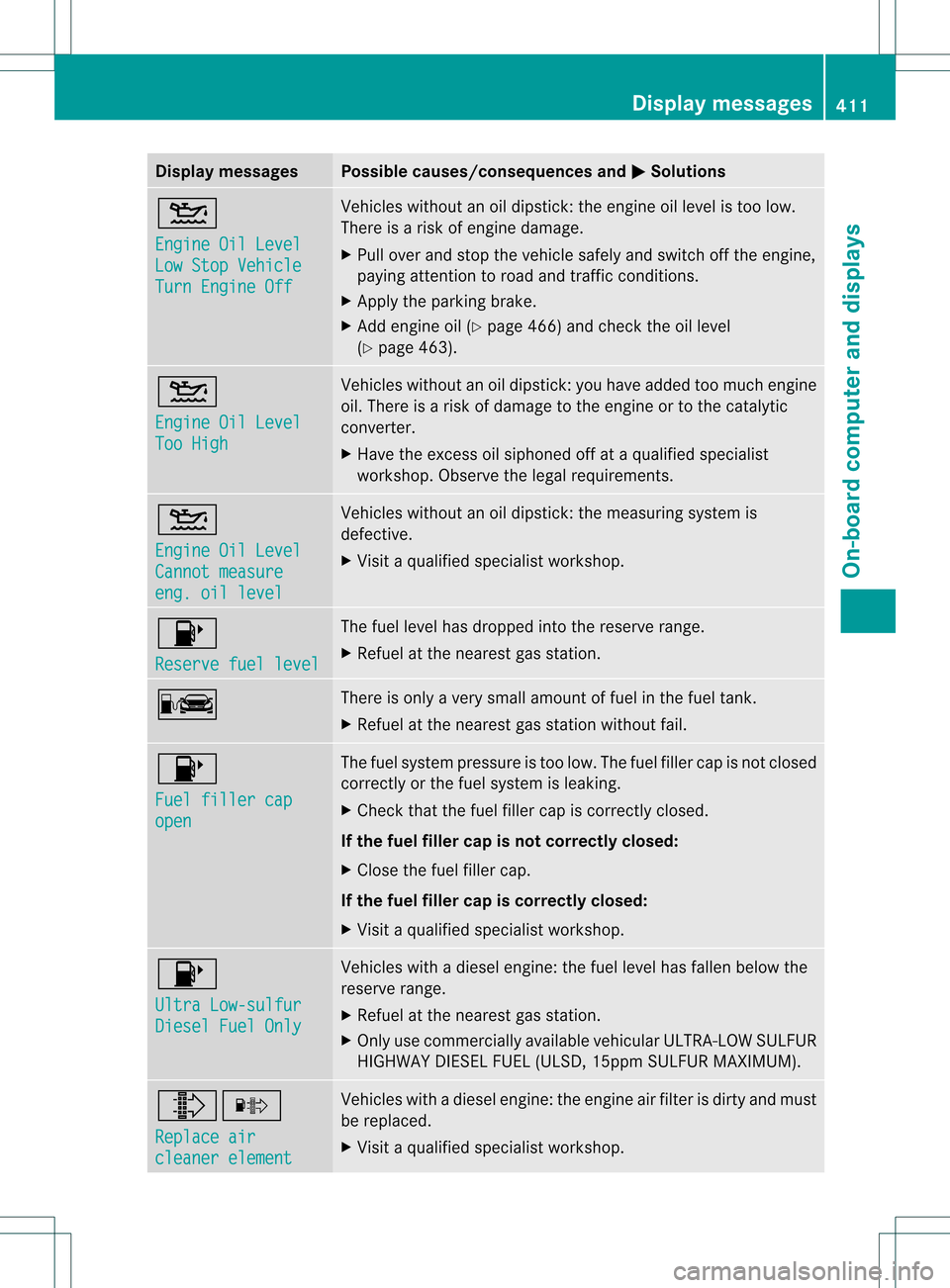
Display messages Possible causes/consequences and
0004 Solutions
0011
Engine Oil Level
Low Stop Vehicle
Turn Engine Off Vehicles without an oil dipstick
:the engine oil level is too low.
There is a risk of engine damage.
X Pull over and stop the vehicle safely and switch off the engine,
paying attention to road and traffic conditions.
X Apply the parking brake.
X Add engine oil (Y page 466) and check the oil level
(Y page 463). 0011
Engine Oil Level
Too High Vehicles without an oil dipstick: you have added too much engine
oil. There is a risk of damage to the engine or to the catalytic
converter.
X
Have the excess oil siphoned off at a qualified specialist
workshop. Observe the legal requirements. 0011
Engine Oil Level
Cannot measure
eng. oil level Vehicles without an oil dipstick: the measuring system is
defective.
X
Visit a qualified specialist workshop. 000F
Reserve fuel level The fuel level has dropped into the reserve range.
X
Refuel at the nearest gas station. 0009 There is only a very small amount of fuel in the fuel tank.
X
Refuel at the nearest gas station without fail. 000F
Fuel filler cap
open The fuel system pressure is too low. The fuel filler cap is not closed
correctly or the fuel system is leaking.
X
Check that the fuel filler cap is correctly closed.
If the fuel filler cap is not correctly closed:
X Close the fuel filler cap.
If the fuel filler cap is correctly closed:
X Visit a qualified specialist workshop. 000F
Ultra Low-sulfur
Diesel Fuel Only Vehicles with a diesel engine: the fuel level has fallen below the
reserve range.
X Refuel at the nearest gas station.
X Only use commercially available vehicular ULTRA-LOW SULFUR
HIGHWAY DIESEL FUEL (ULSD, 15ppm SULFUR MAXIMUM). 00060005
Replace air
cleaner element Vehicles with a diesel engine: the engine air filter is dirty and must
be replaced.
X
Visit a qualified specialist workshop. Display messages
411On-board computer and displays Z
Page 469 of 542
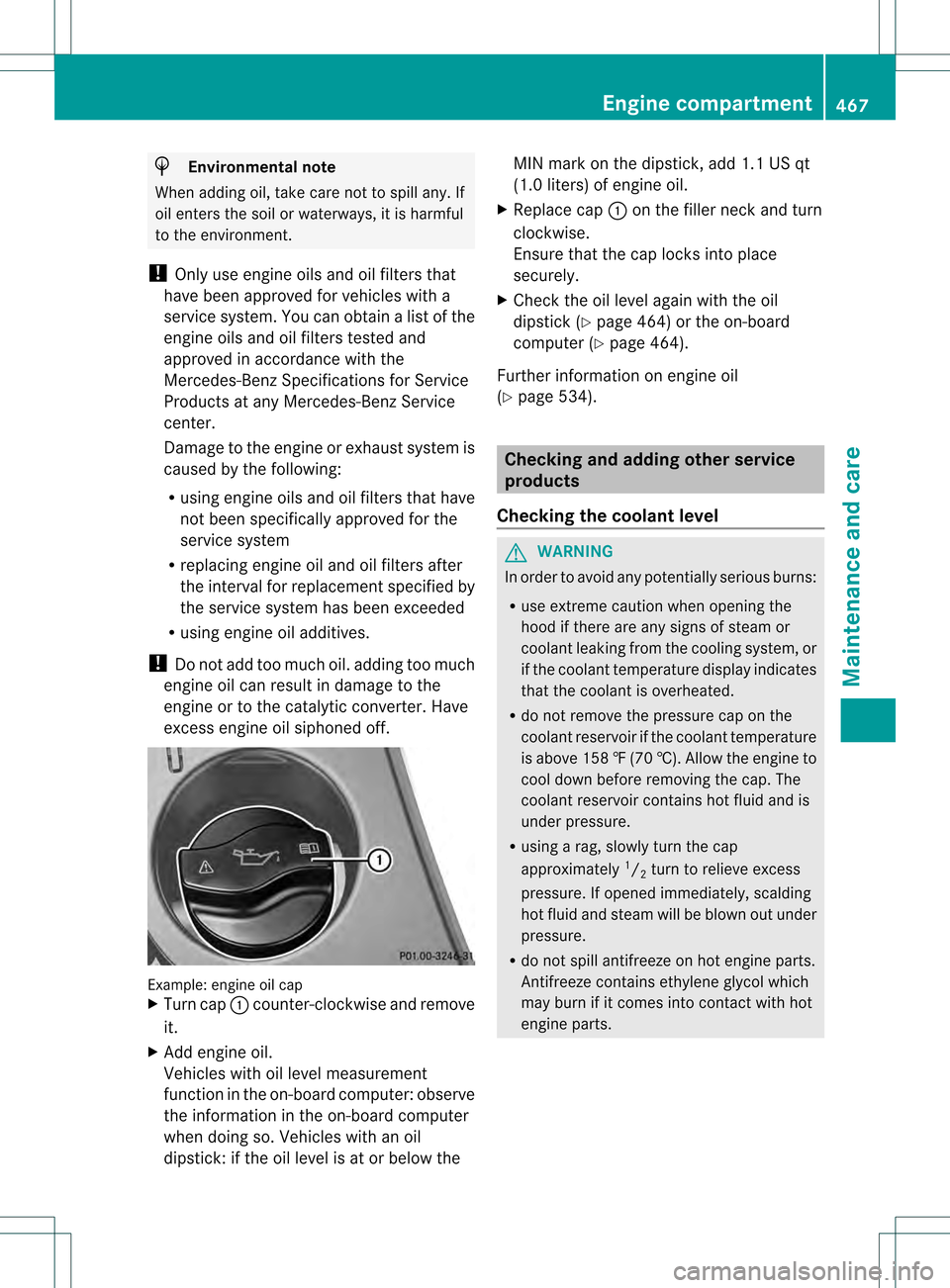
H
Environmental note
When adding oil, take care not to spill any. If
oil enters the soil or waterways, it is harmful
to the environment.
! Only use engine oils and oil filters that
have been approved for vehicles with a
service system. You can obtain a list of the
engine oils and oil filters tested and
approved in accordance with the
Mercedes-Benz Specifications for Service
Products at any Mercedes-Benz Service
center.
Damage to the engine or exhaust system is
caused by the following:
R using engine oils and oil filters that have
not been specifically approved for the
service system
R replacing engine oil and oil filters after
the interval for replacemen tspecified by
the service system has been exceeded
R using engine oil additives.
! Do not add too much oil. adding too much
engine oil can result in damage to the
engine or to the catalytic converter. Have
excess engine oil siphoned off. Example: engine oil cap
X
Turn cap 0002counter-clockwise and remove
it.
X Add engine oil.
Vehicles with oil level measurement
function in the on-board computer: observe
the information in the on-board computer
when doing so. Vehicles with an oil
dipstick: if the oil level is at or below the MIN mark on the dipstick, add 1.1 US qt
(1.0 liters) of engine oil.
X Replace cap 0002on the filler neck and turn
clockwise.
Ensure that the cap locks into place
securely.
X Check the oil level again with the oil
dipstic k(Ypage 464) or the on-board
computer (Y page 464).
Further information on engine oil
(Y page 534). Checking and adding other service
products
Checking the coolant level G
WARNING
In order to avoid any potentially serious burns:
R use extreme caution when opening the
hood if there are any signs of steam or
coolant leaking from the cooling system, or
if the coolant temperature display indicates
that the coolant is overheated.
R do not remove the pressure cap on the
coolant reservoir if the coolant temperature
is above 158 ‡(70 †). Allow the engine to
cool dow nbefore removing the cap. The
coolant reservoir contains hot fluid and is
under pressure.
R using a rag, slowly turn the cap
approximately 1
/ 2 turn to relieve excess
pressure. If opened immediately, scalding
hot fluid and steam will be blown out under
pressure.
R do not spill antifreeze on hot engine parts.
Antifreeze contains ethylene glycol which
may burn if it comes into contact with hot
engine parts. Engine compartment
467Maintenance and care Z
Page 477 of 542
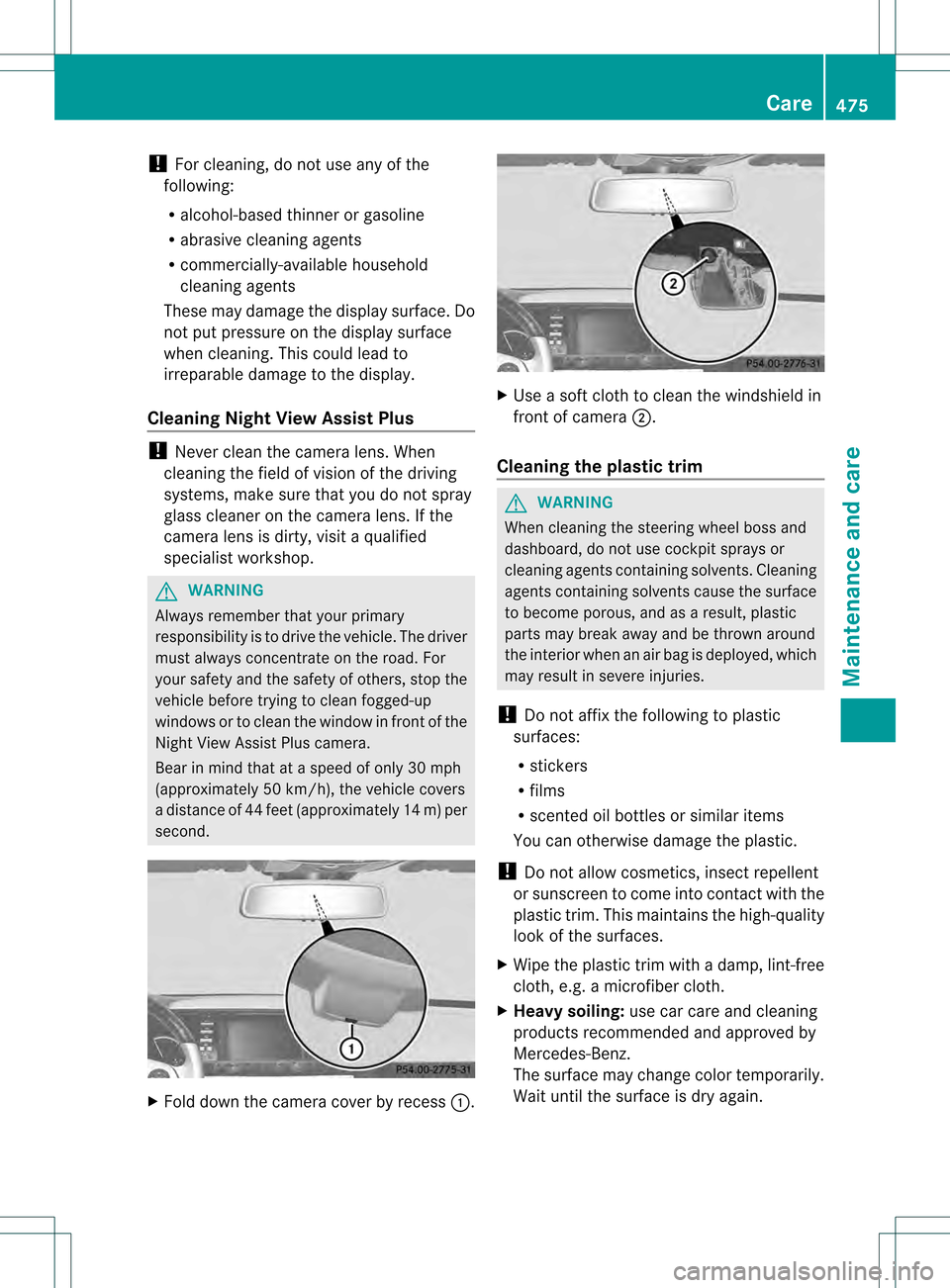
!
For cleaning, do not use any of the
following:
R alcohol-based thinner or gasoline
R abrasive cleaning agents
R commercially-available household
cleaning agents
These may damage the display surface. Do
not put pressure on the display surface
when cleaning. This could lead to
irreparable damage to the display.
Cleaning Night View AssistP lus!
Never clean the camera lens. When
cleaning the field of vision of the driving
systems, make sure that you do not spray
glass cleaner on the camera lens. If the
camera lens is dirty, visit a qualified
specialist workshop. G
WARNING
Always remember that your primary
responsibility is to drive the vehicle. The driver
must always concentrate on the road. For
your safety and the safety of others, stop the
vehicle before trying to clean fogged-up
windows or to clean the window in fron tofthe
Night View Assist Plus camera.
Bear in mind that at a speed of only 30 mph
(approximately 50 km/h), the vehicle covers
a distance of 44 feet (approximately 14 m) per
second. X
Fold down the camera cover by recess 0002. X
Use a soft cloth to clean the windshield in
front of camera 0003.
Cleaning the plastic trim G
WARNING
When cleaning the steering wheel boss and
dashboard, do not use cockpit sprays or
cleaning agents containing solvents. Cleaning
agents containing solvents cause the surface
to become porous, and as aresult, plastic
parts may break away and be thrown around
the interior when an air bag is deployed, which
may result in severe injuries.
! Do not affix the following to plastic
surfaces:
R stickers
R films
R scented oil bottles or similar items
You can otherwise damage the plastic.
! Do not allow cosmetics, insect repellent
or sunscreen to come into contact with the
plastic trim .This maintains the high-quality
look of the surfaces.
X Wipe the plastic trim with a damp, lint-free
cloth, e.g. a microfiber cloth.
X Heavy soiling: use car care and cleaning
products recommended and approved by
Mercedes-Benz.
The surface may change color temporarily.
Wait until the surface is dry again. Care
475Maintenance and care Z
Page 521 of 542
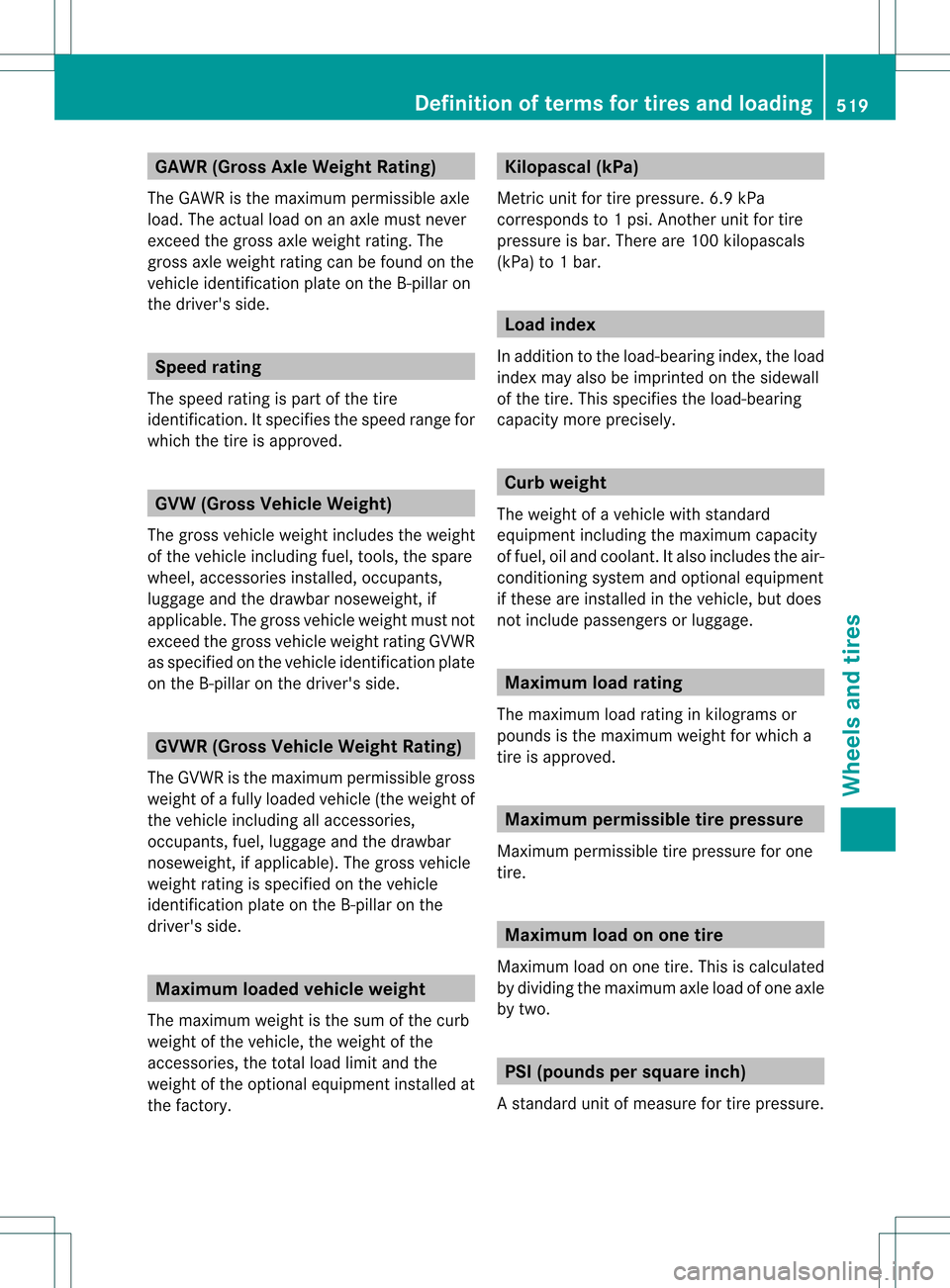
GAWR (Gross Axle Weight Rating)
The GAWR is the maximu mpermissible axle
load. The actual load on an axle must never
exceed the gross axle weight rating. The
gross axle weight rating can be found on the
vehicle identification plate on the B-pillar on
the driver's side. Speed rating
The speed rating is part of the tire
identification .Itspecifies the speed range for
which the tire is approved. GVW (Gross Vehicle Weight)
The gross vehicle weight includes the weight
of the vehicle including fuel, tools, the spare
wheel, accessories installed, occupants,
luggage and the drawbar noseweight, if
applicable. The gross vehicle weight must not
exceed the gross vehicle weight rating GVWR
as specified on the vehicle identification plate
on the B-pillar on the driver's side. GVWR (Gross Vehicle Weight Rating)
The GVWR is the maximum permissible gross
weight of a fully loaded vehicle (the weight of
the vehicle including all accessories,
occupants, fuel, luggage and the drawbar
noseweight, if applicable). The gross vehicle
weight rating is specified on the vehicle
identification plate on the B-pillar on the
driver's side. Maximum loaded vehicle weight
The maximum weight is the sum of the curb
weight of the vehicle, the weight of the
accessories, the total load limit and the
weight of the optional equipment installed at
the factory. Kilopascal (kPa)
Metric unit for tire pressure. 6.9 kPa
corresponds to 1 psi. Another unit for tire
pressure is bar. There are 100 kilopascals
(kPa) to 1bar. Load index
In addition to the load-bearing index, the load
index may also be imprinted on the sidewall
of the tire. This specifie sthe load-bearing
capacity more precisely. Curb weight
The weight of a vehicle with standard
equipment including the maximum capacity
of fuel, oil and coolant. It also includes the air-
conditioning system and optional equipment
if these are installed in the vehicle, but does
not include passengers or luggage. Maximum load rating
The maximum load rating in kilograms or
pounds is the maximum weight for which a
tire is approved. Maximum permissible tire pressure
Maximum permissible tire pressure for one
tire. Maximum load on one tire
Maximum load on one tire. This is calculated
by dividing the maximum axle load of one axle
by two. PSI (pounds per square inch)
As tandard uni tofmeasure for tire pressure. Definition of terms for tires and loading
519Wheels and tires Z
Page 523 of 542
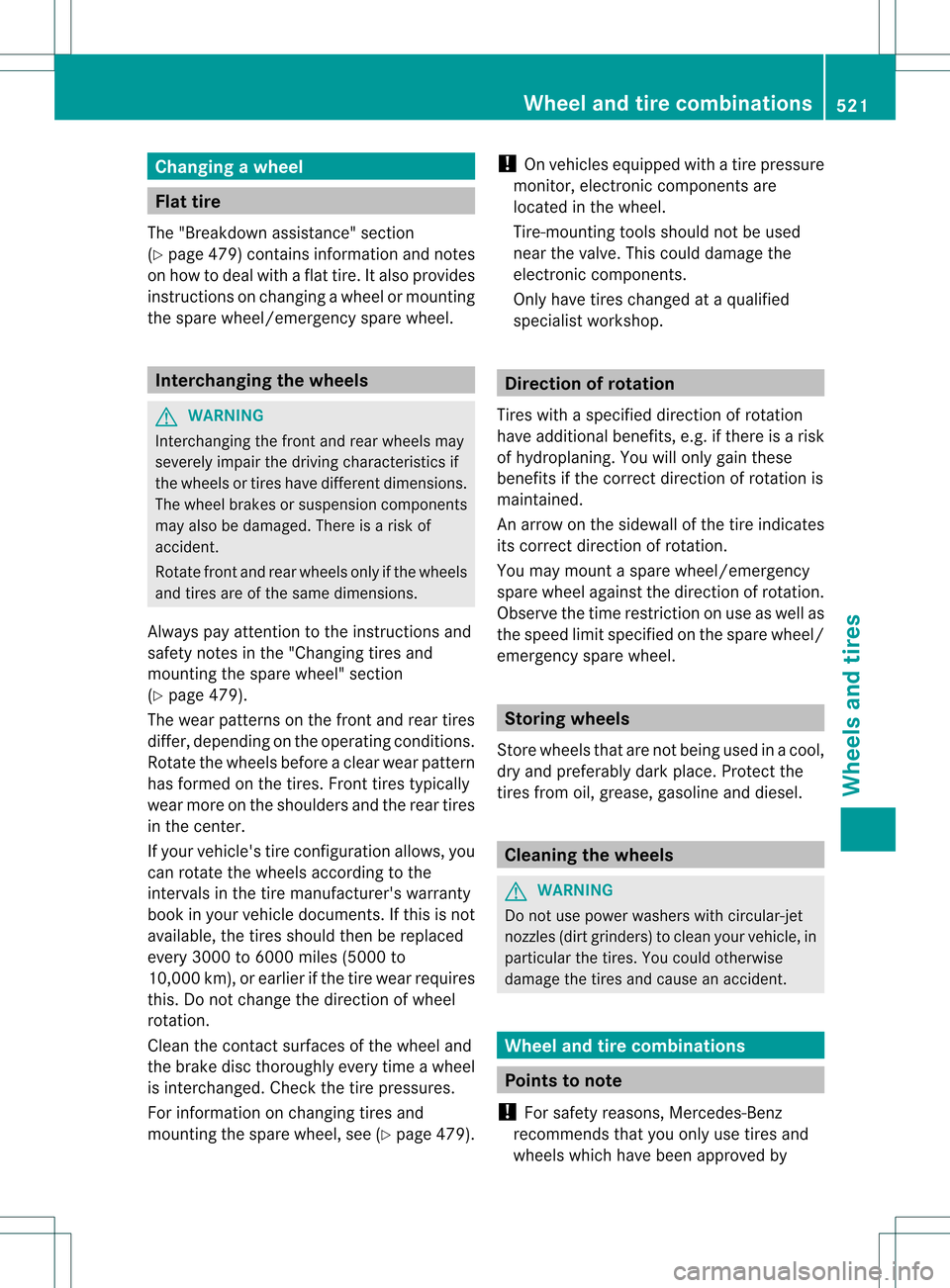
Changing
awheel Flat tire
The "Breakdown assistance" section
(Y page 479) contains information and notes
on how to deal with a fla ttire. It also provides
instructions on changing a wheel or mounting
the spare wheel/emergency spare wheel. Interchanging the wheels
G
WARNING
Interchanging the front and rear wheels may
severely impair the drivin gcharacteristics if
the wheels or tires have different dimensions.
The wheel brakes or suspension components
may also be damaged. There is a risk of
accident.
Rotate front and rear wheels only if the wheels
and tires are of the same dimensions.
Always pay attention to the instructions and
safety notes in the "Changing tires and
mounting the spare wheel" section
(Y page 479).
The wear patterns on the front and rear tires
differ, depending on the operating conditions.
Rotate the wheels before a clear wear pattern
has formed on the tires. Front tires typically
wear more on the shoulders and the rear tires
in the center.
If your vehicle's tire configuration allows, you
can rotate the wheels according to the
intervals in the tire manufacturer's warranty
book in your vehicle documents. If this is not
available, the tires should then be replaced
every 3000 to 6000 miles (5000 to
10,000 km), or earlier if the tire wear requires
this. Do not change the direction of wheel
rotation.
Cleant he contact surfaces of the wheel and
the brake disc thoroughly every time a wheel
is interchanged. Check the tire pressures.
For information on changing tires and
mounting the spare wheel, see (Y page 479).!
On vehicles equipped with a tire pressure
monitor, electronic components are
located in the wheel.
Tire-mounting tools should not be used
near the valve. This could damage the
electronic components.
Only have tires changed at a qualified
specialist workshop. Direction of rotation
Tires with a specified direction of rotation
have additional benefits, e.g. if there is a risk
of hydroplaning. You will only gain these
benefits if the correct direction of rotation is
maintained.
An arrow on the sidewall of the tire indicates
its correct direction of rotation.
You may mount a spare wheel/emergency
spare wheel against the direction of rotation.
Observe the time restriction on use as well as
the speed limit specified on the spare wheel/
emergency spare wheel. Storing wheels
Store wheels that are not being used in a cool,
dry and preferably dark place. Protect the
tires from oil, grease, gasoline and diesel. Cleaning the wheels
G
WARNING
Do not use power washers with circular-jet
nozzles (dirt grinders) to clean your vehicle, in
particular the tires. You could otherwise
damage the tires and cause an accident. Wheel and tire combinations
Points to note
! For safety reasons, Mercedes-Benz
recommends that you only use tires and
wheels which have been approved by Wheel and tire combinations
521Wheels and tires Z